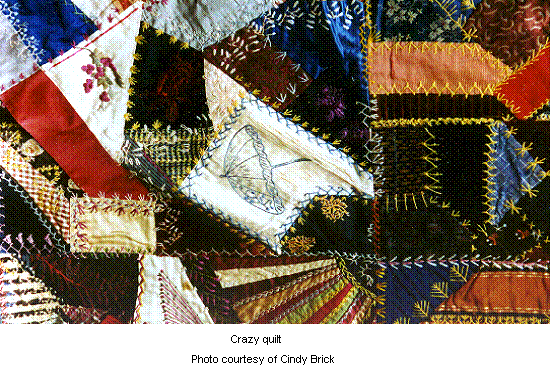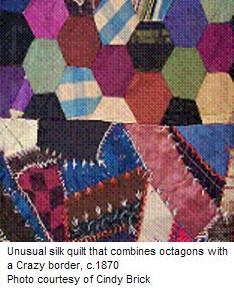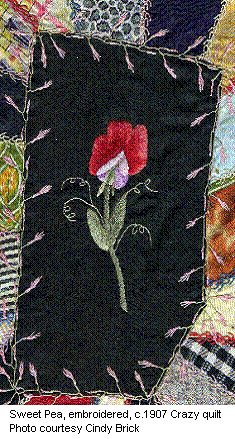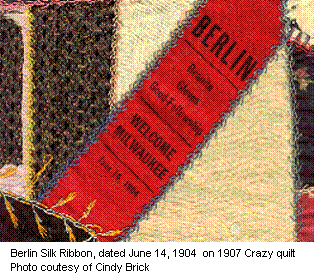|
Quilt History
Today's Quilt Historians
Underground Railroad
Women at Work
|
|
New Pathways into Quilt History written by Kimberly Wulfert,
www.antiquequiltdating.com
THE CRAZE FOR
CRAZY QUILTS BEGAN…. WHEN??
By Cindy Brick |
|
Everyone knows that:
*Crazy quilts are America’s earliest quilt style.
*Crazies are only made from fancy fabrics, like silks and satins.
|
If you agreed with either of these statements, you’re not alone.
Many people have all sorts of misconceptions about the Crazy quilt style, its
age, and its origins. Let’s explore this colorful but often-misunderstood style
a little more.

How old are Crazy quilts? We don’t really know. Camille Cognac, an expert
on Crazy quilts and their restoration, has pointed out that the European
harlequin – that multi-patched jester with bells on his pointed hat – wears a
costume very similar to a Crazy quilt. According to Cognac, textiles with a
crazy-patched look have also been documented in Egyptian tombs.
Quilting-book authors in the early 20th century, including Marie Webster and
Averil Colby, asserted that crazy quilts were the American Colonies’ first
quilts, by necessity. Fabric was scarce and expensive; why not just patch
threadbare quilts with irregular scraps, and keep out the cold one more winter?
Unfortunately, there are no existing Crazies from the colonial period to back
these authors up. Until recently, the oldest documented Crazy quilt, to this
author’s knowledge was thought to be an 1865 version in the collection of the
Shelburne Museum. The Metropolitan Museum of Art has a Contained Crazy, made up
of crazy-patched squares sashed in a striped fabric, with the following
inscription in the middle of the top: Made by Mrs. Nancy Doughty in the 82nd
year of her age for her friend Miss Lizzie Cole, A.D. 1872. (The blocks,
incidentally, are stitched to the sashing by sewing machine.) In the late 1990s,
a stunning Crazy surfaced from the Fitzhugh family estate, and was purchased by
the Maryland Historical Society . It i s dated 1839 – nearly three decades
before its nearest cousin! (You can see this amazing quilt, and learn more about
it, in my 2008 book from Voyageur Press, Crazy Quilts. See the end of
this article for more info.)
How did the Crazy quilt style begin? A pre-World War I catalog from
Joseph Doyle & Co., in Newark, New Jersey, makes it easy for us:
It may interest many to know that the first ‘crazy quilt’ was made at
Tewkesbury (Mass.) almshouse by a demented but gentle inmate, who delighted to
sew together, in haphazard fashion, all the odd pieces given her. One day a lady
visitor was shown the quilt as a sample of ‘poor Martha’s crazy work.’ The
conglomeration of color, light and dark, of every conceivable shape and size,
caught the visitor’s fancy, and within a week she, herself, was making a crazy
quilt. And thence the furor spread…
 Although
thoughts of ‘poor Martha’ are appealing, the Crazy quilt really seems to have
sprung from a combination of factors begun by the Industrial Revolution. By
1850, American companies were manufacturing good-quality fabrics that were
colorfast more often than not. (Consistently colorfast fabrics were not
generally available until later in the 19th century, when washday blues,
mourning blacks and Turkey reds appeared.) Fabric prices moderated. Thanks to
higher-paying factory jobs, women could actually afford to buy cloth, instead of
going to the trouble of weaving it – an option they often took in the 18th and
early 19th centuries. Also, sewing machines, which had been used by commercial
sewers for years, became increasingly affordable for the average family, thanks
to the advent of the “layaway plan.” Family sewing was accomplished more
quickly, giving the average woman time for more genteel pursuits, like
embroidery and lacemaking. Although
thoughts of ‘poor Martha’ are appealing, the Crazy quilt really seems to have
sprung from a combination of factors begun by the Industrial Revolution. By
1850, American companies were manufacturing good-quality fabrics that were
colorfast more often than not. (Consistently colorfast fabrics were not
generally available until later in the 19th century, when washday blues,
mourning blacks and Turkey reds appeared.) Fabric prices moderated. Thanks to
higher-paying factory jobs, women could actually afford to buy cloth, instead of
going to the trouble of weaving it – an option they often took in the 18th and
early 19th centuries. Also, sewing machines, which had been used by commercial
sewers for years, became increasingly affordable for the average family, thanks
to the advent of the “layaway plan.” Family sewing was accomplished more
quickly, giving the average woman time for more genteel pursuits, like
embroidery and lacemaking.
The Civil War changed all that. Fabrics, if they were available at all,
skyrocketed in price – especially for the South, which had few factories of any
kind. Women’s extra energy went toward their families, instead of fancywork.
Exhibitions, called sanitary fairs, became a popular way of showing off one’s
skills, as well as collecting quilts, shirts and funds for soldiers. It is from
this period, at a Sanitary Fair in Cleveland, Ohio, that the first published
mention of Crazy quilts appears. In February 1864, Mary Brayton wrote:
Above the grim surroundings of this busy corner hangs the ‘crazy bedquilt,’ a
grotesque piece of newspaper patchwork, which is sold by lot every day, with the
express condition that the unlucky possessor is not obliged to keep it, but will
be allowed to present it to the fair. A considerable sum of money and a great
deal of fun are realized by this transaction which takes place every noon just
as the clock strikes twelve.
Perhaps Mrs. Brayton’s complaints were just sour grapes that she never won the
bid! Only a year later, Peterson’s Magazine was recommending “mosaic appliqué”
and “oriental embroidery” for a look quite similar to today’s “controlled” Crazy
quilts. By 1874, the “grotesque” Crazy had been renamed “ornamental fancy work”
in the pages of Peterson’s. The war was over; prosperity had begun. And everyone
was thinking about stitching a Crazy quilt.
 What
fabrics does a Crazy quilt use? All of the earliest examples, so far, at
least, were made from cottons. Period. (Only one is embroidered or embellished:
the Shelburne quilt.) It wasn’t until after the Civil War, when Log Cabin-style
silk quilts began appearing, that the Crazy quilt style seemed to become
associated with the fabrics we now call “fancies:” silks, satins, velvets and
such. What
fabrics does a Crazy quilt use? All of the earliest examples, so far, at
least, were made from cottons. Period. (Only one is embroidered or embellished:
the Shelburne quilt.) It wasn’t until after the Civil War, when Log Cabin-style
silk quilts began appearing, that the Crazy quilt style seemed to become
associated with the fabrics we now call “fancies:” silks, satins, velvets and
such.
For one thing, these elaborate fabrics began to be more reasonably priced. By
the 1880s, even a rural housewife could afford silk for her best dress. Packets
of silk scraps were readily available from textile companies, who saw the Crazy
quilt trend as a great way to make a profit on what was previously considered a
throwaway item.
Other companies, including magazines, joined the rush by offering patterns,
patterns, fabrics, threads, laces. There were even ready-made embroideries that
could be stitched on a Crazy top, much like the jacket patches available today.
And women responded in a rush. An 1884 book, Crazy Patchwork, asserts,
“The so-called Crazy-Quilt, which seemed destined to but an ephemeral
popularity, has, within the last few months, gained a firmer hold upon the
public mind; so that now the fancy for making such quilts is literally a craze.”
Even The National Stockman and Farmer, in its Feb. 28, 1889 issue, was
urging, “A nice way to use up worsted scraps of all kinds is to piece them as
‘crazy work’ for a comforter…” Only the editor of Godey’s Lady’s Book was
still saying in 1887 that “the time, patience, stitches and mistakes the crazy
quilt represents…[are] too awful for words.” No one cared, though. They were too
busy planning their next Crazy quilt.
Queen Victoria, England’s ruler during the latter half of the 19th century, was
also an unwitting influence on the Crazy quilt style. Her Majesty loved
embroidery and rich fabrics, to begin with, and favored the cluttered look in
home decorating. When her beloved husband Albert died, the queen went into
mourning for the rest of her life. The rich dark fabrics she favored, as well as
the sentimental themes and keepsakes she prized, soon became an essential part
of the Victorian-era Crazy quilt.< o:p>
Another major influence was the Centennial Exposition, held in Philadelphia,
Pennsylvania. People from all over the country flocked to the city to celebrate
America’s 100th anniversary. They admired the Glass Pavilion, constructed of
huge glass panels. And they gawked at displays hosted by countries from around
the world.
But the most popular exhibit, by far, was from Japan. (It’s no surprise that
Gilbert and Sullivan’s famous operetta, “The Mikado,” dates from this period.)
Americans fell madly in love with the delicate Japanese porcelains and fabrics.
They stared at the dainty women in kimonos and admired, among other things, an
unusual floor screen, made up of “crazed,” or unevenly-broken pieces, and
highlighted with lavish edgings. Soon the “crazed” look of the screen, as well
as Japanese motifs, designs and colors, added their own flavors to the Crazy
quilt trend.
Women took pride in scrounging their silk patches – or worse. Many a young man
sacrificed a favorite silk handkerchief or tie so his lady fair could add a
patch to her quilt. A poem from The National Stockman and Farmer, c. January
1891, says, in horrified tone:
Oh the crazy quilt mania triumphantly raves,
And maid, wife, and widow are bound as its slaves.
On that quilt dimly seen as you rouse from your sleep
Your long-missing necktie in silence reposes.
And the filoselle insects that over it creep,
A piece of your vest half-conceals, half-discloses…
Your breakfasts are spoiled,
And your dinners half-boiled,
And your efforts to get a square supper are foiled
By the crazy quilt mania that fiendishly raves,
And to which all women are absolute slaves…
But make it she must,
She will do it or bust,
Beg, swap, and buy pieces, or get them on trust.
Oh, the crazy quilt mania, may it soon cease to rave
in the land of the free and the home of the brave.
|
It wasn’t until the 1890’s that interest in Crazy quilts changed. Now a new kind of Crazy emerged, sewn mostly of wools and embroidered
with wool yarn or silk floss, made in bed-comforter sizes for warmth. (Previous
Crazy quilts were more decorative than useful, and became throws, cushions,
curtains, and even robes and slippers.) Crazy quilts from fancy fabrics were
still made in great quantities, as well. New embellishments were available,
small “tobacco silks” or “cigarette silks,” printed in a wide variety of motifs,
and offered as premiums in cigarette packs. Women wouldn’t be smoking cigarettes
– God forbid! But they could and would encourage the menfolk to smoke a certain
brand so they could get the latest actress or bathing beauty silk. (The men
probably enjoyed these lissome lovelies, too.)
changed. Now a new kind of Crazy emerged, sewn mostly of wools and embroidered
with wool yarn or silk floss, made in bed-comforter sizes for warmth. (Previous
Crazy quilts were more decorative than useful, and became throws, cushions,
curtains, and even robes and slippers.) Crazy quilts from fancy fabrics were
still made in great quantities, as well. New embellishments were available,
small “tobacco silks” or “cigarette silks,” printed in a wide variety of motifs,
and offered as premiums in cigarette packs. Women wouldn’t be smoking cigarettes
– God forbid! But they could and would encourage the menfolk to smoke a certain
brand so they could get the latest actress or bathing beauty silk. (The men
probably enjoyed these lissome lovelies, too.)
By the 1920’s, when interest in other traditional methods of quilting had
revived, the Crazy quilt trend began to slow down. A hefty amount of Crazies
from the 1920-40 period have endured, but they often make use of the
newly-available synthetic satins and rayons, as well as the more traditional
silks and velvets. Although the Crazy was put on fashion’s back burner, women
continued to stitch Crazy quilts throughout the years. Perhaps these crazy
quilters had made them in their youth – or perhaps they liked the Crazy style
too much to quit.
In 1984, Penny McMorris’ Crazy Quilts was followed in 1988 by
America’s Glorious Quilts, which featured an extensive chapter on Crazy
quilts. Handcrafters flocked to learn silk embroidery techniques from Judith
Montano, who was eventually joined by people like Faye Labanaris, Dorothy Bond,
and Ellie Sienkiwicz, all teachers and writers in their own right. Montano’s
books, including the Crazy Quilt Handbook, Crazy Quilt Odyssey and a host
of embroidery stitch collections, were runaway bestsellers, and the circle was
complete. Crazy quilts were back.
Today, you can choose from a blizzard of Crazy quiltmaking fabrics, threads, and
embellishments, as well as books and patterns for every level, including both
hand and machine techniques. Crazy quilting groups exist all over the country,
including the national Crazy Quilting Society. Perhaps the Crazy quilt style was
pegged as only for the insane when it first appeared. Nowadays, though, you’d be
crazy not to try it!
Want to learn more about the history and influences of the Crazy quilt? Look
for a copy of Cindy Brick’s CRAZY QUILTS, a 2008 publication from Voyageur
Press. It not only contains history and cultural trends, but dozens of glorious
color photos of Crazies past and present, as well as a pattern/method guide for
making – and embellishing – Crazies four different ways. Contact Cindy at the
Brickworks website
http://www.cindybrick.com, or call toll-free 1-888-48-BRICK.
For more information on the Crazy Quilt Society and its annual conference, write
the Crazy Quilt Society, P.O. Box 19452, Omaha, NE 68119; call 1-800-599-0094;
fax 1-800-811-1610; or e-mail QuiltHF@aol.com.
Or visit the Crazy Quilt Society website at
www.crazyquilt.com
|
*
Quilts
© 2007 - 2022 Kimberly Wulfert, PhD. Absolutely no copies, reprints, use
of photos or text are permitted for commercial or online use. One personal copy for study purposes is permitted.
|
Fabrics & Dyes
Rugs & Textiles
Books & Reviews
Resource Links
Home
|